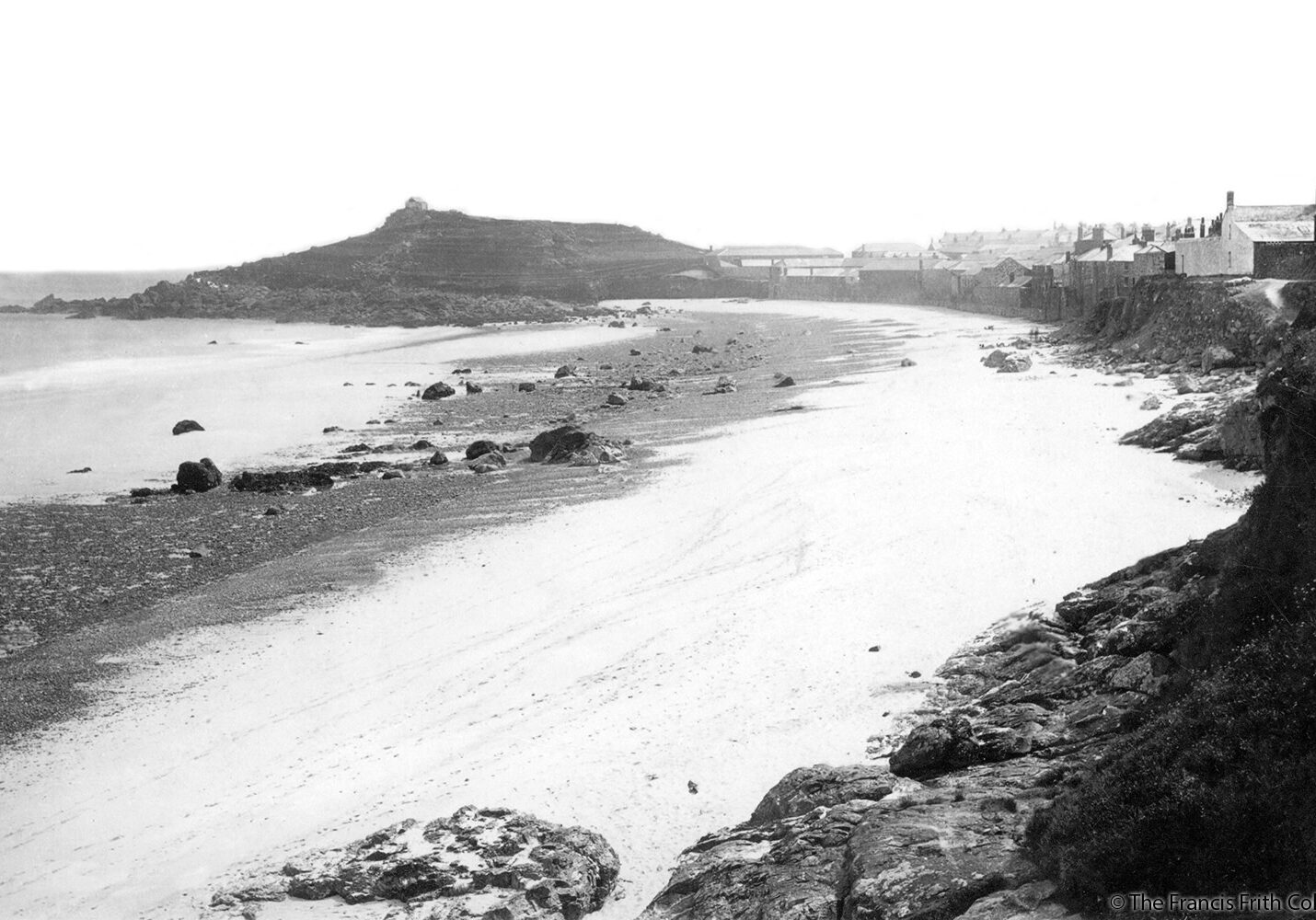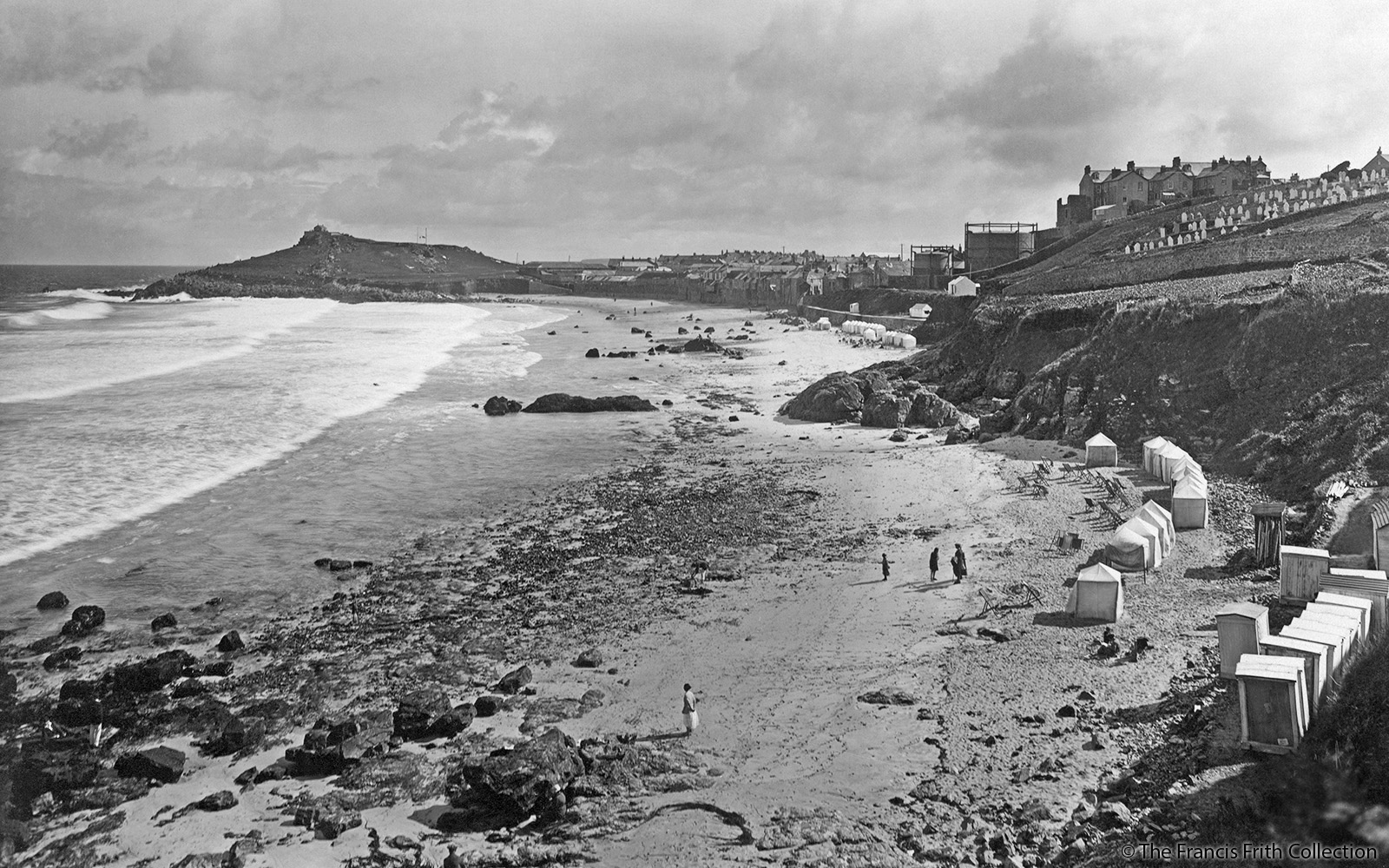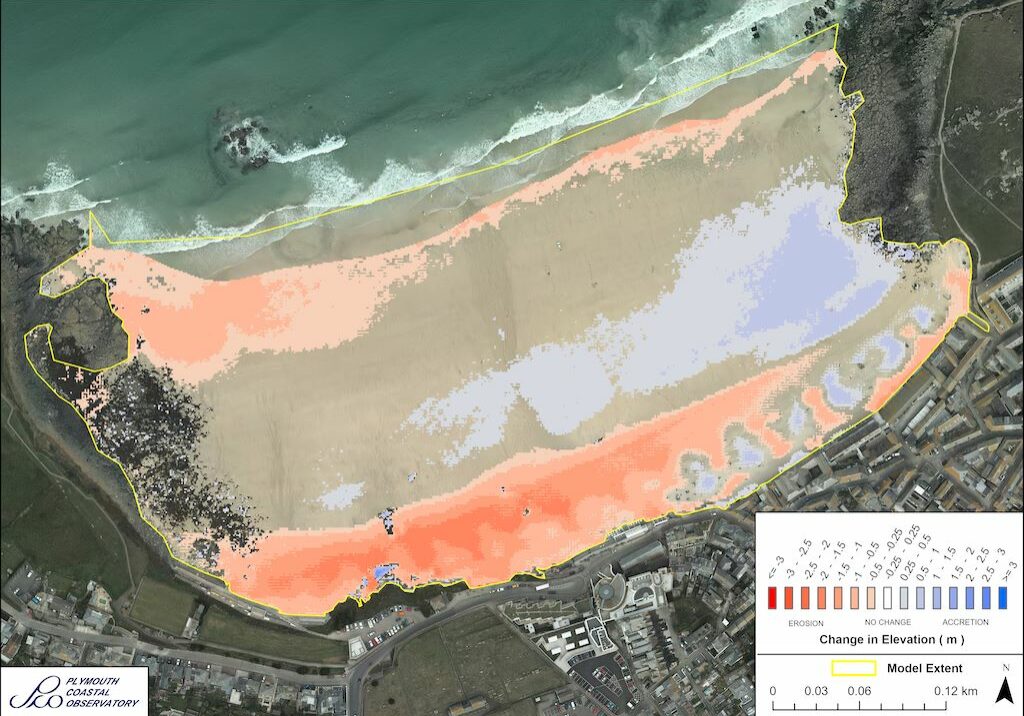
Porthmeor (Cornish: Porth Meur, meaning ‘great cove’) is a wide north facing beach, on the edge of St Ives Bay, on the north coast of Cornwall. The western side of the beach is backed by the low, steep cliffs of Carrick Du. With eastward progression, the frontage becomes more heavily defended. Porthmeor is overlooked by the Tate Gallery, numerous artist studios and apartments that have been converted from old fish cellars and stores, evidence of the towns more industrial past.
The beach of Porthmeor sits between two prominent headland features of Carrick Du to the west and St Ives Head to the east (Cornish: Pedn Enys, meaning ‘Head Island’). A large portion of the town is built on an isthmus (a narrow strip of land, with sea on either side), much of which is protected by seawall structures. With no space being available for the coastline to rollback it makes parts of St Ives more vulnerable to storm surges and more sensitive to sea level rise.


Coastal Change
The coastline of Cornwall is an ever-changing environment. It is energetic, dynamic, never still and changes with each wave and each tidal cycle. Some of the changes we see are gradual and barely noticeable, whilst others, such as rockfalls, happen suddenly and often shockingly.
From one visit to the next it can sometimes be difficult to see how a beach and dune system has changed, but information has been collected, and is being collected through the Making Space for Sand project, to help us better understand how the coastline is changing. The purpose of this section of the website is to understand each location has changed over time, how it could change in the future and understand the policies that influence how we can respond to these changes.
Shoreline Management Plans (SMP)
The Shoreline Management Plan (SMP) is a strategic planning and management assessment tool that helps identify and measure the risk associated coastal erosion and coastal flooding. The document makes a number of policy recommendations over short, medium and long term timeframes setting out a strategic approach to managing the built, natural and historic environments associated with the coastline. Within SMP there are four policy approaches which have been assigned to stretches of coastlines. The four policies are: No Active Intervention (NAI), Hold the Line (HTL), Managed realignment (MR), and Advance the line (ATL).
Porthmeor sits within Policy Development Zone 10 (PDZ10), in Management Area 25 (MA25), within Policy Units (PU) 25.1 and 25.2. The policy recommendations for these policy units are detailed in the table below and the SMP can be accessed through the Cornwall Council website.
Use your touchscreen
to scroll the below table
| Policy Unit | SMP2 Policy Plan | ||||
| 2025 | 2055 | 2105 | Comment | ||
| 25.1 | Undefended cliffs
Main Policy Sub Policy
|
NAI DnD |
NAI DnD |
NAI DnD |
Low erosion rates along undefended cliff sections. NAI will meet high level objectives and satisfy AONB and Heritage Coast requirements. Allow natural coastal evolution to occur to support conservation interest of protected sites.
|
| 25.2 | Porthmeor
Main Policy Sub Policy
|
HTL M/R |
HTL M/R |
HTL M/R |
Economic justification for HTL should remain. Some increasing pressure along the frontage may occur in line with sea level rise and residential housing fronting directly onto the beach may be at risk beyond mid-century. Continue to maintain defences along Porthmeor beach with few options for managed realignment. This may become unsustainable in the long term without some community adaptation. Monitoring must continue to take place with an adjustment of strategy necessary if it appears that there is a risk of losing the beach entirely.
|
| Key Main Policy: HTL - Hold the Line, A - Advance the Line, NAI – No Active Intervention MR – Managed Realignment
Sub Policy: DnD – Do not Defend, M/R – Maintain/Replace |
|||||


National Coastal Erosion Risk Mapping (NCERM)
National Coastal Erosion Risk Mapping (NCERM) provides a baseline of coastal erosion, for the coastline of England, over short, medium and long-term timeframes. The data is based on the natural and defence characteristics of the coastline and provides rates of erosion at differing levels of confidence to help better plan for worse case scenarios. The data provided is for guidance and does not estimate the absolute location of the future coastline.
The basic NCERM lines show erosion estimates for the Short Term (ST-20 years), Medium Term (MT-50 years) and Long Term (LT- 100 years). The data is further categorised by probability: 05 is 5% probability (a 1 in 20 chance of being exceeded) Red Shading, 50 is 50% probability of being exceeded (a 1 in 2 chance of being either exceeded or not exceeded) Orange Shading and 95 is 95% probability (a 19 in 20 chance of being exceeded) Yellow Shading. Click the link below to access the Cornwall Council NCERM Mapping site read the about section then click on layers.

Historical Images
Historical photographs provide a powerful insight into how the Cornish coastline has changed within the past Century. The Making Space for Sand project are working in collaboration with the Francis Frith collection and have been given permission to share historical images on a number of beaches considered within the project.
In looking back, we can better understand how the coastline has changed, helping us understand not only how the coastal fringe has developed but also the potential future changes that we my observe. When this is considered alongside forecasts of coastal erosion and sea level rise it will help enable us to better adapt to our changing coastline.


Modelling Coastal Change

Using data that has already been collected, combined with data collected through the Making Space for Sand project, a series of models will be carried out at each location. This will help us better understand how each location may respond to sea level rise and gain a deeper understanding of how coastal sediments move and behave.
The complexity of the modelling, and the data collection that helps inform it, means that modelling outputs will not be the same on all sites. Some locations will be more thoroughly investigated to understand more complex issues and provide data that can be more widely applied to other sites with similar characteristics.
As the project develops this section of the website will expand, sharing new reports and coastal change projections when they are produced.
LiDAR surveys, which are explained on the Data Modelling page, have been carried out by the South West Coastal Monitoring program at this location. The image shared here visualises where sand has eroded (areas shaded in red) and where it has built up (areas shaded in blue), between the LiDAR surveys carried out in 1998 and 2020. The darker the shade of red or blue the greater the amount of sand erosion or accumulation has been observed. The image helps visualise that beaches are areas that change shape over time and will continue to do so as sea levels rise.


Designations
The coastline represents an important transition between the marine environment and the terrestrial environment. This transition creates a range of special habitats and exposes a range of interesting features, which that can result in these spaces being highly designated and protected. There are a range of designations that recognise a variety of different features. At this location these designations are explored below.
Site of Special Scientific Interest
A Site of Special Scientific Interest or SSSI is a statutory conservation designation notified by Natural England denoting protection for biological and/or geological characteristics. The natural wildlife and geological features of SSSI’s are considered to be irreplaceable parts of the national heritage. These are protected in order to preserve their importance, and to prevent damage and development.
Image of waves breaking on a rocky shore
Aire Point to Carrick Du SSSI
The Aire Point to Carrick Du SSSI covers an area of 704.8 hectares along the coastal fringe of west Cornwall. The site is dominated by vertical sea cliffs formed by the Land's End granite and expose an unparalleled range of geological features throughout the Variscan Orogeny, a mountain building event that occurred over 350 million years ago. The vegetation of the cliffs exhibits a complex of maritime and sub-maritime communities. The cliff slopes and tops are characterised by maritime grassland, heath and scrub communities with frequent species rich flushes. The secluded cliff ledges and coastal habitat provide nesting sites and forage for a diversity of birds and the remote coves and islands provide breeding sites for Grey seals.
Image of a grey seal basking in the sun (Courtesy of Susan Scott)
Area of Outstanding Natural Beauty (AONB)
From November 2023, all areas previously know as Areas of Outstanding Natural Beauty, or AONBs, were re-named National Landscape and in Cornwall became Cornwall National Landscape. However, the Management Plan still references the term AONB as this was formally adopted by Cornwall Council and cannot be amended until the next plan is produced.
Cornwall National Landscape ares are protected landscapes whose distinctive character and natural beauty are so outstanding that it is in the nation’s interest to safeguard them. As such they have been nationally designated by the same legislation as National Parks and have the same status and level of protection.
West Penwith Section of the Cornwall National Landscape
The West Pentwith section covers an area of 13,762 hectares, which is 14.3% of the total Cornwall National Landscape. The key landscape characteristics of West Penwith are shaped by its granite geology and geographical position at the end of the land – exposed to the full force of the Atlantic Ocean. The hard granite coastline has been sculpted by wind and weather into a sequence of headlands punctuated by substantial cliff chasms or ‘zawns’.
Image of the sunset at Botallack (Courtesy of James Reed)
Sign up to Making Space for Sand
If you would like to get involved in helping to make dunes more resilient and biodiverse, want to help develop coastal adaptation and emergency plans or just want to know more about what the project is learning about coastal change, please click here:



